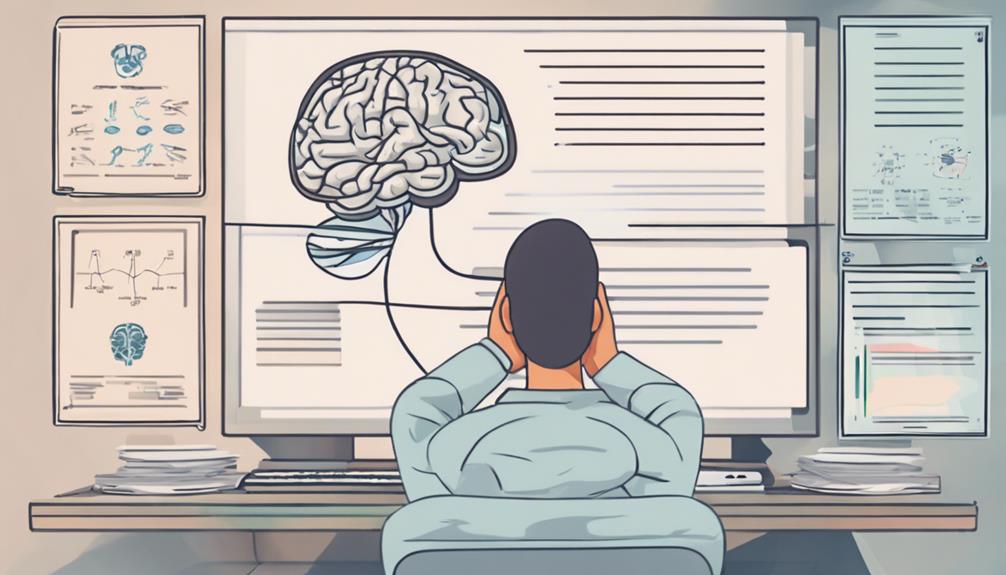To navigate ethical boundaries in subliminal hypnosis practice, practitioners must balance the power of subconscious messaging with ethical considerations. Prioritizing informed consent, avoiding manipulative techniques, and ensuring transparency in messaging are crucial. Upholding integrity, professionalism, and client well-being is paramount in ethical hypnosis practice. By understanding the complexities and challenges in this field, practitioners can safeguard ethical standards while respecting client autonomy. This delicate balance is essential for fostering trust and maintaining ethical integrity in hypnosis sessions.
Understanding Subliminal Messaging

An essential aspect of delving into the realm of subliminal hypnosis practice involves a comprehensive understanding of the concept of subliminal messaging. Subliminal messaging refers to the technique of conveying information to an individual's subconscious mind without their conscious awareness. This method aims to bypass the critical faculties of the conscious mind and directly target the subconscious for processing.
The subconscious mind, unlike the conscious mind, operates beneath the surface level of awareness, influencing thoughts, behaviors, and emotions.
Subliminal messaging relies on the principle that the subconscious mind can absorb information without the individual consciously perceiving it. By presenting stimuli below the threshold of conscious perception, subliminal messages can potentially influence attitudes or behaviors. However, the effectiveness of subliminal messaging remains a topic of debate within the scientific community, with research showing mixed results.
Understanding the dynamics of conscious awareness and subconscious processing is crucial when exploring the ethical implications of utilizing subliminal messaging in hypnosis practice. It is essential to consider the potential impact of manipulating subconscious processes without the individual's explicit consent or awareness.
Importance of Informed Consent
Understanding the ethical framework of subliminal hypnosis practice necessitates a meticulous examination of the pivotal role of informed consent. Informed consent is a fundamental ethical principle that ensures individuals are fully aware of the nature of the hypnosis session, potential risks, benefits, and any alternative options before deciding to participate.
Practitioners have ethical obligations to provide clients with clear and comprehensive information about the techniques used, the purpose of the session, and the potential outcomes. It is crucial for individuals to voluntarily consent to participate in subliminal hypnosis without any coercion or deception.
Informed consent empowers clients to make autonomous decisions about their involvement in subliminal hypnosis sessions, fostering a relationship built on trust and respect between the practitioner and the client. By obtaining informed consent, practitioners uphold ethical standards and prioritize the well-being and autonomy of their clients.
Failure to obtain informed consent can lead to ethical violations and undermine the integrity of the therapeutic relationship in subliminal hypnosis practice.
Limitations of Subliminal Influence

Exploring the boundaries of subliminal influence in hypnosis practice reveals inherent limitations that impact the efficacy and ethical considerations of such techniques.
While subliminal messages can potentially access the subconscious mind and influence behavior, there are ethical dilemmas surrounding the use of these techniques. The subconscious influence raises concerns about the potential for manipulation and coercion, challenging the professional boundaries of hypnotherapists.
Moreover, the psychological impact of subliminal influence is complex and not fully understood. The extent to which individuals are susceptible to subliminal messages varies, and there is a risk of unintended consequences when attempting to influence the subconscious mind.
This uncertainty highlights the need for caution and ethical reflection when incorporating subliminal techniques into hypnosis practice.
Avoiding Manipulative Techniques
The importance of upholding ethical standards in hypnosis practice necessitates a vigilant approach to avoiding manipulative techniques. Ethical considerations and professional boundaries are paramount when engaging in subliminal hypnosis to ensure the well-being and autonomy of clients.
Manipulative techniques can include the use of coercive language, deceitful practices, or exploiting vulnerabilities for personal gain, all of which can undermine the trust and integrity essential in therapeutic settings.
To avoid manipulative techniques, practitioners must prioritize transparency, informed consent, and respect for the individual's right to make autonomous decisions. Building a strong therapeutic alliance based on honesty and respect is fundamental in upholding ethical standards.
Practitioners should continuously evaluate their methods, intentions, and the impact of their interventions on clients to prevent unintentional harm or manipulation.
Transparency in Messaging

Effective communication in subliminal hypnosis practice hinges on the clarity and honesty conveyed in messaging to clients. Message clarity is paramount in ensuring that clients understand the nature of the hypnosis session, the goals, and any potential outcomes.
As a practitioner, there is an ethical responsibility to provide transparent information about the techniques used, the purpose of the session, and any potential risks involved. Transparent messaging fosters trust between the practitioner and the client, setting a foundation for a positive therapeutic relationship.
It is essential to communicate in a straightforward manner, using language that is easily understandable and free of ambiguity. Clients should be informed about the process of subliminal hypnosis, the role they play in the session, and any limitations or uncertainties associated with the practice.
Risks of Unethical Practices
Navigating ethical boundaries in subliminal hypnosis practice requires a keen awareness of the risks associated with unethical practices. One significant risk is unethical manipulation, where the hypnotist uses subliminal techniques to influence individuals without their consent or knowledge. This can lead to the exploitation of vulnerable individuals and the erosion of trust in the practice of hypnosis.
Another risk to consider is the presence of hidden agendas within the hypnotist's motivations. When hidden agendas drive the hypnosis session, the focus shifts from the well-being of the client to fulfilling the hypnotist's personal goals or desires. This can result in a breach of ethical standards and harm to the client's mental and emotional health.
To mitigate these risks, hypnosis practitioners must adhere to strict ethical guidelines, prioritize the welfare of their clients, and maintain transparency in their practices.
Client Well-being in Focus

Maintaining a client-centered approach is crucial in ensuring the ethical practice of subliminal hypnosis. Client well-being should always be the primary focus of any hypnotist, with a strong emphasis on client empowerment and ethical responsibility. By prioritizing the client's welfare, hypnotists can create a safe and supportive environment for the practice of subliminal hypnosis.
Client empowerment is a fundamental aspect of promoting well-being in hypnosis sessions. Hypnotists should aim to empower their clients by fostering autonomy, encouraging self-expression, and respecting their choices throughout the hypnotic process. This empowerment can lead to greater client satisfaction and positive outcomes.
Moreover, hypnotists have an ethical responsibility to prioritize the well-being of their clients above all else. This responsibility entails upholding professional standards, respecting client confidentiality, and ensuring that all interventions are in the client's best interest. By adhering to these ethical principles, hypnotists can build trust with their clients and promote a positive therapeutic relationship that fosters growth and healing.
Ethical Guidelines for Hypnotists
Adhering to established ethical guidelines is paramount for hypnotists to ensure the integrity and professionalism of their practice. When considering ethical considerations in hypnosis, hypnotists must be mindful of the power they hold over individuals' subconscious minds through hypnotic suggestions. It is essential for hypnotists to respect professional boundaries and be cautious of the potential subconscious influence they may exert during sessions.
Ethical guidelines for hypnotists often emphasize the importance of obtaining informed consent from clients before initiating any hypnosis sessions. This process ensures that clients are aware of the hypnotist's intentions and the nature of the hypnotic suggestions that will be used.
Additionally, maintaining confidentiality and privacy regarding the information shared during sessions is crucial to uphold ethical standards in hypnosis practice.
Furthermore, ethical hypnotists prioritize the well-being of their clients above all else, refraining from exploiting their vulnerabilities or manipulating them for personal gain.
Frequently Asked Questions
Can Subliminal Messages Be Used for Personal Gain?
Subliminal messages have the potential for personal gain, but ethical considerations must govern their use. Employing manipulation techniques raises concerns about personal responsibility and professional boundaries, necessitating caution and adherence to ethical standards.
How Can Hypnotists Ensure Client Confidentiality?
Hypnotists can ensure client confidentiality by upholding professional standards, maintaining secure records, and obtaining informed consent. Safeguarding client trust and privacy is an ethical responsibility that forms the foundation of a therapeutic relationship.
Is There a Way to Measure the Effectiveness of Subliminal Messaging?
When evaluating subliminal messaging impact, researchers employ various methods such as controlled experiments and neuroimaging. Ethical considerations in measuring effectiveness must address consent and potential harm. Marketing strategies utilizing subliminal messaging should align with ethical guidelines.
What Steps Should Be Taken if a Client Shows Negative Reactions?
In situations where a client displays negative reactions during subliminal hypnosis practice, it is crucial to prioritize client comfort and well-being. Uphold professional boundaries by promptly addressing concerns, offering support, and if necessary, modifying or discontinuing the session.
Are There Regulations on the Use of Subliminal Techniques in Therapy?
Ethical standards in therapy dictate the use of subliminal techniques. Legal implications vary by jurisdiction. Regulations may exist that govern their application. Adhering to professional guidelines and staying informed on local laws is crucial for practitioners.
Conclusion
In conclusion, maintaining ethical boundaries in subliminal hypnosis practice is crucial for the well-being of clients and the integrity of the profession. By emphasizing informed consent, transparency in messaging, and avoiding manipulative techniques, hypnotists can ensure that their practices are ethical and respectful.
It is important to always prioritize the client's well-being and follow established ethical guidelines to uphold the standards of the field.








































